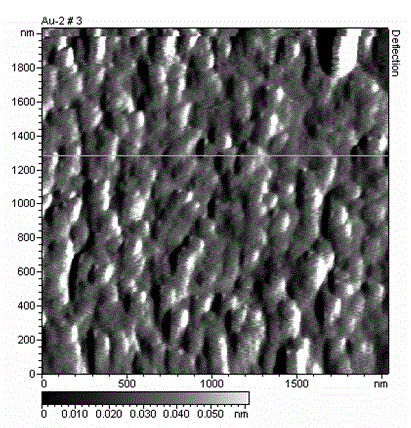Film having protein adsorption resistance and preparation method thereof
An anti-protein adsorption and thin film technology, applied in electrolytic organic production, electrolytic organic material coating, electrolytic components, etc., to achieve the effects of reducing non-specific protein adsorption, good permeability, and strong manufacturability
- Summary
- Abstract
- Description
- Claims
- Application Information
AI Technical Summary
Problems solved by technology
Method used
Image
Examples
Embodiment 1
[0027] The film of this embodiment is prepared by the following method:
[0028] (1) Bromination of the enzyme electrode: first place the enzyme electrode in 0.1mol / L, pH=8 phosphate buffered saline (PBS), dissolve 10ul BIBB in 0.5ml dichloromethane, then add the aforementioned PBS dropwise , stirred at 800 rpm for 1 hour; the brominated enzyme electrode was taken out, washed with deionized water, and dried at room temperature;
[0029] (2) Preparation of polymer monomer solution: take 8 g of sulfobetaine methacrylate (SBMA) monomer, dissolve it in 20 ml of PBS with a pH of 7.4 at 0.1 mol / L, and add the catalyst at a final concentration of 5 mmol / l Divalent copper ion solution, add ligand bipyridine (BPY) at a final concentration of 5 mmol / l, mix thoroughly to form a clear solution;
[0030] (3) Electrically induced atom transfer radical polymerization: the brominated enzyme electrode was used as the working electrode, the silver / silver chloride electrode was used as the refe...
Embodiment 2
[0033] The film of this embodiment is prepared by the following method:
[0034] (1) Bromination of the enzyme electrode: first place the enzyme electrode in 0.1mol / L, pH=8 PBS, dissolve 10ul of dibromoisobutyryl bromide (BIBB) in 0.5ml of dichloromethane, and then add it dropwise In the aforementioned PBS, stir at 800 rpm for 1 hour; take out the brominated enzyme electrode, wash it with deionized water, and dry it at room temperature;
[0035] (2) Preparation of polymer monomer solution: Take 8g of SBMA monomer, dissolve it in 20ml of PBS with a pH of 7.4 at 0.1mol / L, add the catalyst divalent copper ion solution at a final concentration of 5mmol / L, and add a solution of divalent copper ions at a final concentration of 5mmol / L Add the ligand tris(2-pyridylmethyl)amine (TPMA) and mix well to form a clear solution;
[0036] (3) Electrically induced atom transfer radical polymerization: the brominated enzyme electrode was used as the working electrode, the silver / silver chlor...
Embodiment 3
[0039] The film of this embodiment is prepared by the following method:
[0040] (1) Bromination of the enzyme electrode: first place the enzyme electrode in 0.2mol / L, pH=8 PBS, dissolve 5ul BIBB in 1ml dichloromethane, add dropwise to the aforementioned PBS, at 800 rpm Stir for 1 hour; take out the brominated enzyme electrode, wash it with deionized water, and dry it at room temperature;
[0041] (2) Preparation of polymer monomer solution: take 1 g of SBMA monomer, dissolve it in 20 ml of PBS with a pH of 8 at 0.2 mol / L, add the catalyst divalent copper ion solution at a final concentration of 5 mmol / L, and add a solution of divalent copper ions at a final concentration of 10 mmol / L Add the ligand BPY and mix well to form a clear solution;
[0042] (3) Electrically induced atom transfer radical polymerization: the brominated enzyme electrode was used as the working electrode, the silver / silver chloride electrode was used as the reference electrode, the platinum wire electr...
PUM
| Property | Measurement | Unit |
|---|---|---|
| thickness | aaaaa | aaaaa |
| thickness | aaaaa | aaaaa |
Abstract
Description
Claims
Application Information
 Login to View More
Login to View More - R&D
- Intellectual Property
- Life Sciences
- Materials
- Tech Scout
- Unparalleled Data Quality
- Higher Quality Content
- 60% Fewer Hallucinations
Browse by: Latest US Patents, China's latest patents, Technical Efficacy Thesaurus, Application Domain, Technology Topic, Popular Technical Reports.
© 2025 PatSnap. All rights reserved.Legal|Privacy policy|Modern Slavery Act Transparency Statement|Sitemap|About US| Contact US: help@patsnap.com



